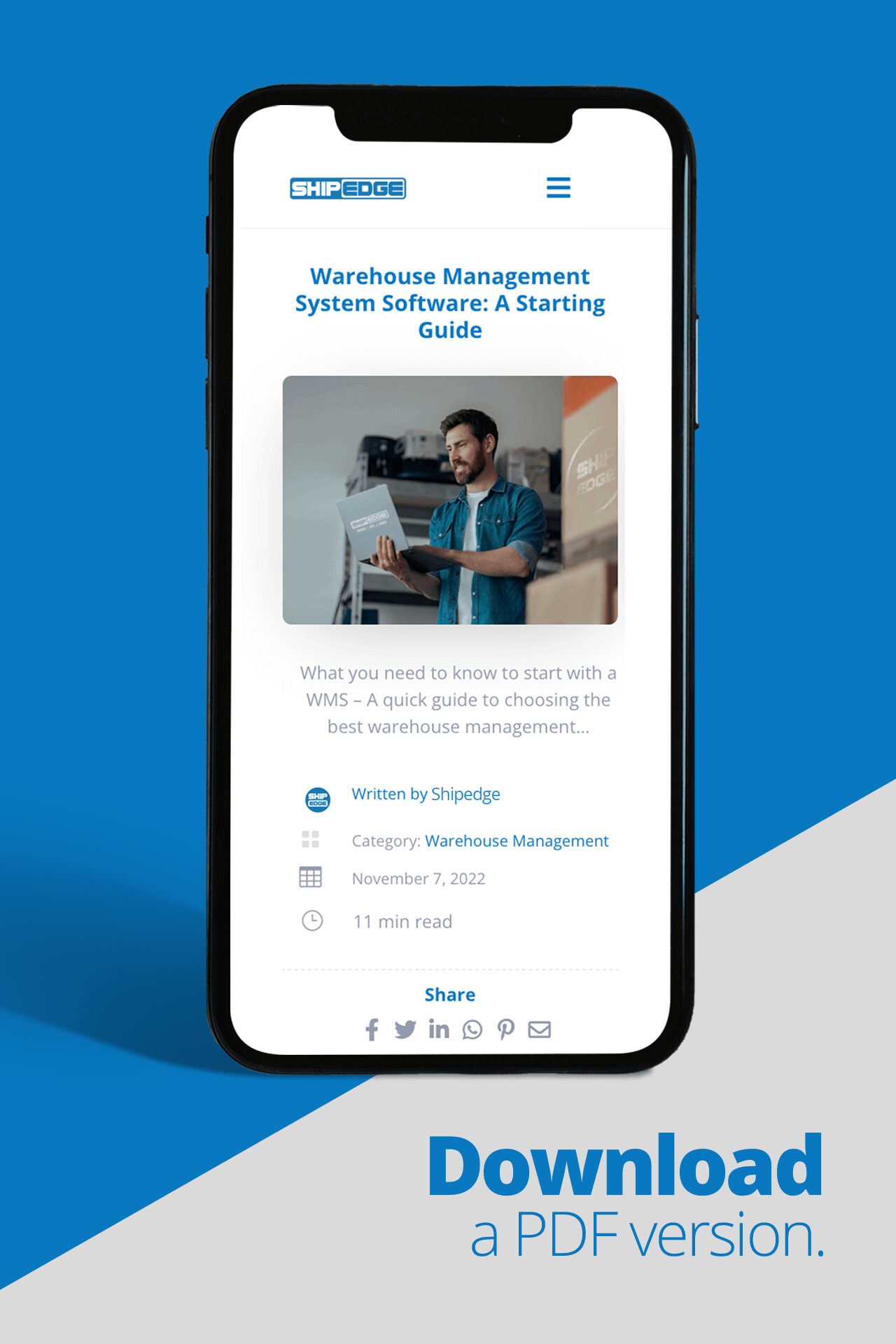In today’s dynamic business landscape, a robust supply chain is the cornerstone of success for large enterprises. It directly influences their ability to deliver products or services efficiently and meet customer demands.
This article delves into e-commerce supply chains, providing insights into how large companies can create a resilient and effective supply chain that drives business growth. We will also explore Shipedge WMS, a software solution that seamlessly integrates into these supply strategies to optimize operations and maximize value.
What is an e-commerce supply chain?
The e-commerce supply chain encompasses a sequence of logistical operations crucial for the functioning of an online store. These operations span acquiring raw materials, manufacturing final products, inventory oversight, warehousing, order processing, and the last leg of product delivery to customers.
More specifically, within this supply chain, goods and products traverse from sellers or suppliers to buyers, with payments flowing from buyers to sellers. Information exchange is integral at various points along the chain, facilitated by the online nature of the business.
The overarching objective of maintaining an effective supply chain is to ensure the delivery of high-quality products to customers, enhancing the overall e-commerce customer experience. Supply chain management plays a pivotal role in achieving this goal.
READ MORE: Building Customer Trust with Transparent Supply Chain Practices
How does the e-commerce supply chain work?
E-commerce supply chain management oversees the seamless movement of products, resources, and information among various levels of suppliers and buyers. This progression, commonly referred to as the e-commerce logistics process, comprises five essential stages and involves distinct participants:
1- Suppliers
The supplier acquires the necessary raw materials for product creation and delivers them to a manufacturing facility for assembly. Some products may already be assembled and require no further fabrication processes. These inbound goods, materials, or finished products proceed to the e-commerce warehouse.
2 – Warehouse
The warehouse, as the second phase of this e-commerce logistics process, serves as the storage and management hub for inventory until it is ready to be delivered to customers. Maintaining accurate inventory records is crucial at this stage, and inventory management software can enhance visibility into stock levels, location, and restocking schedules.
3 – Fulfillment Center
After a purchase is made on your e-commerce platform, the transition of the product from the warehouse to the fulfillment center is a pivotal step closer to reaching customers. The fulfillment center is responsible for packaging and shipping goods, although, in some cases, the warehouse may also function as a fulfillment center.
4 – Carrier
The carrier, often a courier service like USPS, FedEx, DHL, or UPS, delivers the packaged goods to their final destination. While internal packaging processes are an option, courier services typically provide various packaging choices to ensure the safe transit of products during their journey to customers.
5 – Customer
Customers represent the final participants in the e-commerce supply chain.
Ideally, customers receive and enjoy the products, resulting in mutual satisfaction. However, it’s essential to anticipate the possibility of product returns for reasons such as defects, issues, or even instances of e-commerce fraud. This necessitates consideration of reverse logistics, the process by which purchased goods are returned to the seller.
Discover how our WMS can improve your business
What are the main benefits of efficient e-commerce supply chain management?
E-commerce supply chain management plays a crucial role in the success and efficiency of online businesses. Here are some key benefits:
1 – Improved visibility and tracking
One key aspect of managing an efficient supply chain is utilizing real-time data and visibility into inventory levels, order statuses, and shipment tracking. This transparency allows businesses to make informed decisions and respond quickly to changes in demand or supply chain disruptions.
2 – Efficient inventory management
By automating inventory processes in your warehouse from receiving to picking and packing, inventory levels will constantly be up-to-date. Automating inventory management in warehouses helps to prevent overstocking or stockouts, reducing carrying costs and minimizing the risk of obsolete or expired products.
READ MORE: Managing Excess Inventory: How to Avoid Overstock and Optimize Warehouse Operations
3 – Reduced costs
Streamlining supply chain processes through automation and better visibility can reduce costs. Businesses can save on labor and operational expenses by minimizing manual errors, optimizing routes, and improving efficiency.
4 – Faster order fulfillment
E-commerce supply chain management systems enable faster and more accurate order processing. Automation of order fulfillment processes, such as picking, packing, and shipping, helps reduce lead times and improve customer satisfaction.

5 – Enhanced customer experience
Efficient supply chain management contributes to a positive customer experience. A combination of quick order processing, accurate inventory information, and on-time deliveries results in satisfied customers more likely to return for future purchases.
6 – Scalability
E-commerce businesses often experience fluctuations in demand, especially during peak seasons. An effective supply chain management system can scale to accommodate increased order volumes without compromising efficiency or customer satisfaction.
READ MORE: How to Manage Seasonal Inventory Fluctuations in Your Warehouse
7 – Risk mitigation
Businesses can proactively mitigate disruptions by identifying and addressing potential risks in the supply chain. This includes monitoring supplier performance, diversifying suppliers, and having contingency plans for unexpected events.
8 – Data-driven decision making
E-commerce supply chain management systems generate a wealth of data that can be analyzed to make informed business decisions. Analytics tools help businesses understand trends, identify areas for improvement, and optimize their overall supply chain strategy.
9 – Global Reach
E-commerce allows businesses to reach a global customer base. An effective supply chain management system helps manage the complexities of international logistics, customs, and regulations, enabling businesses to operate seamlessly across borders.
In summary, efficient e-commerce supply chain management offers a range of benefits, from cost savings and efficiency improvements to enhanced customer satisfaction and global scalability. It is a critical component for the success of online businesses in today’s competitive market.
What are effective strategies for e-commerce supply chain management?
Building a strong supply chain is an ongoing process that requires adaptability and responsiveness to changing market conditions. Regularly reassessing and refining strategies will help large companies maintain a competitive edge. Now, let’s explore four strategies that can guide us through challenging situations:
1 – Harnessing Technology
Utilizing technology encompasses deploying technological solutions to guarantee the supply chain’s swift adaptation to disruptions and the continual flow of goods and services.
This involves utilizing advanced tracking technologies to monitor the progress of goods in transit and the application of predictive analytics to foresee market trends and meet customer needs.
Additionally, it involves incorporating automation and robotics to streamline operations. Technology enhances communication among suppliers, buyers, and customers, fostering a more effective exchange of information and improved collaboration.
Employing technology as a strategic approach to constructing a resilient supply chain is instrumental in ensuring the supply chain’s capacity to endure disruptions while sustaining optimal efficiency.
Discover how our WMS can improve your business
2 – Commit to collaborations
Fostering partnerships involves establishing solid connections with suppliers, customers, and key stakeholders.
This approach empowers companies with improved access to information and resources, facilitating swift responses to market changes. It is particularly effective in identifying potential risks.
Furthermore, it enables companies to capitalize on economies of scale, leading to cost efficiencies. Strengthening relationships with suppliers ensures the timely and cost-effective sourcing of materials. Additionally, it plays a vital role in effective supplier management.
Investing in partnerships enhances the supply chain’s security and resilience and equips companies to identify and prepare for potential disruptions.
3 – Supervise Operations
Supervising operations entails systematically collecting and analyzing data related to supply chain activities to pinpoint potential risks and vulnerabilities.
This proactive approach enables businesses to take necessary measures to mitigate these risks, enhancing the overall resilience of the supply chain.
Through the careful monitoring of supply chain activities, businesses gain a deeper understanding of their operations, identifying areas for improvement. This insight empowers them to implement necessary changes, reinforcing the supply chain and minimizing the impact of potential disruptions.
Furthermore, this monitoring process aids in identifying cost-saving opportunities and enhancing operational efficiency. Additionally, it provides valuable insights into supplier performance, ultimately facilitating improved management of supplier relationships.

4 – Establish Contingency Plans
A backup strategy is a proactive approach to anticipate potential disruptions, encompassing unforeseen events like natural disasters, political unrest, labor strikes, and other disturbances.
This method is valuable for protecting businesses and formulating a structured response plan for such occurrences.
The plan should include:
- Identifying alternative suppliers.
- The creation of alternative shipping routes.
- Establishing backup systems for manufacturing and supply chain operations.
Moreover, backup strategies may involve measures to secure alternative sources of capital in case of financial challenges.
How Shipedge Helps Support Supply Chain Operations
Shipedge is a cloud-based order fulfillment platform that provides solutions for managing e-commerce operations, warehouse management, and order processing.
To integrate Shipedge into a company’s supply chain strategies, consider the following aspects:
1 – Order Fulfillment Efficiency
Shipedge’s advanced order processing capabilities streamline fulfillment operations, reducing processing times and minimizing errors. To enhance efficiency, utilize automated order routing, pick and pack optimization, and prioritization.
2 – Real-time Inventory Tracking and Management
Shipedge provides real-time visibility into inventory levels, allowing for accurate tracking and management. Utilize its inventory management tools to prevent stockouts or overstock situations, optimizing inventory levels based on demand.
READ MORE: Maximize Your E-Commerce Success with Real-Time Inventory Management
3 – Visibility and Reporting
Shipedge offers comprehensive reporting tools for insights into key performance indicators (KPIs). Leverage these reports to gain visibility into various aspects of your supply chain, helping in informed decision-making and proactive issue resolution.
4 – Leverage Shipedge’s Reporting and Analytics Features
Utilize Shipedge’s reporting and analytics features to analyze historical data, identify trends, and forecast demand. This information can aid in making data-driven decisions to optimize supply chain processes.
5 – Scalability with a Cloud-Based WMS
The cloud-based architecture of Shipedge ensures scalability is simple, allowing businesses to adapt to changes in order volume and expand operations without the need for significant infrastructure investments.
READ MORE: Tailoring success: why large e-commerce brands need custom software solutions
6 – Multi-channel Integration
Shipedge facilitates integration with multiple sales channels, centralizing order management. This enables a seamless flow of information between different platforms, reducing the likelihood of errors and improving order accuracy.
7 – Compliance and Traceability
Shipedge includes compliance management and product traceability features. Ensure that your supply chain adheres to regulatory requirements and utilizes traceability features to respond to any product recall or compliance audit quickly.
8 – Regularly Review and Optimize Processes
Periodically review and optimize your supply chain processes using Shipedge’s performance metrics. Identify areas for improvement, implement changes, and continuously refine your strategies for maximum efficiency and effectiveness.
Conclusion
In the fast-paced world of e-commerce, a resilient and efficient supply chain is the linchpin for success among large enterprises. This article has delved into the intricacies of e-commerce supply chains, emphasizing their critical role in facilitating seamless product delivery and elevating overall customer satisfaction.
From the foundational stages involving suppliers, warehouses, fulfillment centers, carriers, and customers to the myriad benefits such as improved visibility, cost savings, and enhanced customer experiences, the importance of a well-managed supply chain is undeniable.
The article outlined critical approaches for large e-commerce companies to fortify these strategies. Leveraging Technology, fostering collaborations, closely supervising operations, implementing backup plans, and establishing contingencies emerged as vital proactive measures to build resilience and adaptability.
In this landscape, the integration of Shipedge WMS stands out as a comprehensive solution. From optimizing order fulfillment to real-time inventory tracking, the platform’s cloud-based scalability and features like multi-channel integration and supplier collaboration equip companies with the tools needed for a seamless and efficient supply chain.
As large e-commerce enterprises navigate the challenges and opportunities of the digital marketplace, the combined strategic planning, technological utilization, and integration of specialized solutions like Shipedge offer a robust framework. This approach enables companies to weather disruptions effectively and positions them for sustained growth and success in the ever-competitive online business arena. If you are looking for solutions to improve your supply chain performance, Shipedge WMS can offer the perfect solutions. Know how in the text point.
Discover how our WMS can improve your business











0 Comments